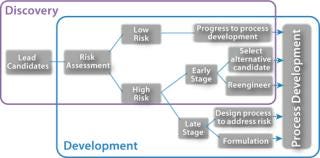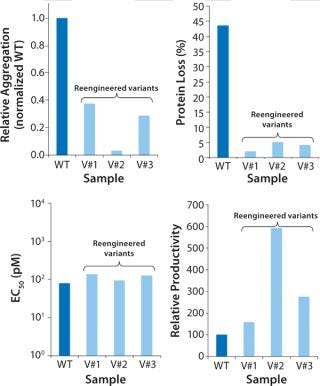The ultimate objective in the development of any new therapeutic candidate is the validation of its mechanism of action and therapeutic efficacy in a clinical setting. Three important areas of product development are critical in determining the success of a new drug candidate: manufacturing, safety, and delivery of the product to patients. Early attrition observed during preclinical and initial stages of clinical development fundamentally resides in problems with manufacturing, stability, or safety issues.
A Potential Risk for Everyone: The Cost of Failure
The probability of failure for any new therapeutic candidate during development is extremely high. The Pharmaceutical Research and Manufacturers of America (PhRMA) reports as few as one in 250 candidates in preclinical development will ever be approved for commercial use, and payer constrains on the reimbursement of new therapeutics adds an additional challenge. In this context, the financial impact of preclinical and clinical attrition is often not sufficient attention.
Figure 1: ()
From a drug development perspective, a significant financial commitment is made for the development of a qualified manufacturing process well before the product has even been cleared for its assessment in clinical trials. This investment is at risk subject to success at various preclinical and clinical development stages. In addition, potential manufacturing or safety concerns can impact candidate attrition in many ways:
Extend development timelines (reducing market exclusivity period).
Require additional investment in process development, optimization, or implementation of corrective measures.
Stop a program, preventing it from entering clinical development.
Cause the failure of a program during clinical trials requiring a repeat of trials or prevent final commercial approval due to quality or safety concerns.
These issues can be worth many millions in lost opportunities or investments lacking a return. Therefore, it is desirable to avoid such costly issues by selecting the candidate with the highest probability of success early in its development by asking the right questions.
What Is Developability?
Developability assessment can be considered a truly integral approach to quality by design (QbD) methodologies. Developability is not about identifying every type of problem that can negatively impact a given therapeutic candidate. Rather, it is about assessing and managing risk by implementing adequate corrective measures early in the development program.
Traditional implementation of QbD strategies in biopharmaceutical manufacturing has been primarily restricted to areas of process validation and process robustness. Current practice ignores perhaps the single most important aspect of “designing” product quality: the process of designing and optimizing desired quality attributes in the molecular structure of a given therapeutic product.
The Three Pillars of Developability
Developability assesses the different aspects that give a therapeutic candidate its desired characteristics. A new therapeutic candidate needs to answer the following questions: Can it be made (at the right cost)? Is it stable? Can it be formulated for intended route of administration? Is it safe for patients? Can it access the desired tissue, at the required dose, for the required time? Will it exert the desired biological activity and show therapeutic effectiveness? These questions can be grouped into three different categories:
Manufacturability: productivity (yield), stability of the product, degradation and impurity profile, formulability
Safety: immunogenicity, immunotoxicology, specificity, and so on
Pharmacology and biological activity: bioavailability, half-life, formulability for intended route of administration, immunomodulation, and so on.
Each of those categories has a potential relationship with the others. For example, low stability can result in aggregation, causing safety issues (immunogenicity). In addition, the ability of a product to be formulated for a specific route of administration can significantly impact the bioavailability and pharmacology (and by extension the efficacy) of a given candidate.
A Three-Stage Process
Developability can be applied to early derisking and seamlessly integrated with discovery and process development activities. A developability assessment program consists of three different stages:
Stage 1: Risk assessment
Stage 2: Implementing mitigation strategy (selecting alternative candidates, redesigning a candidate, and/or modifying the process)
Stage 3: Validating a corrective course of action
Assessing Risk: The simplest and most cost-effective way of assessing risk is by implementing computational approaches able to predict specific developability features by using the sequence of the biopharmaceutical candidates as a single input. These methodologies can have an extraordinarily high throughput and are relatively simple to implement.
The probability of occurrence for a given event (e.g., a degradation pathway) needs to be balanced by its potential impact (the process or biological consequence if this event occurred). The combination of the two can provide a measure of the “criticality” of the event and suggest whether it is advisable to introduce a corrective course of action (mitigation strategy) for this issue. This type of approach fits well with traditional RMA (risk mitigation assessment) used in QbD strategies.
Implementing a Risk-Mitigation Strategy: Predicting potential problems serves no purpose if it is not accompanied by corrective actions or mitigation strategies to address them. Depending on where in the process the risk assessment has taken place, there are different courses of action that can be considered. Early in the development cycle, for example, before cell-line development, two different routes can be taken:
an alternative candidate can be selected that has a more favorable risk fingerprint, or
reengineering can occur to correct those issues identified in the risk-assessment stage.
Figure 2 shows an example of a biotherapeutic candidate that was reengineered to correct issues related to aggregation propensity. The modified candidates show improved stability compared to that of the parental compound, while retaining biological activity and improved productivity. In this particular case, a full reengineering program was performed in under three months, including risk assessment, reenginee
ring candidates, and testing.
Figure 2: ()
When the product is in process development, or for cases in which reengineering is not an option, then process-related strategies can help ameliorate the behavior of a given product. Potential strategies could include screening larger numbers of clones during cell-line development, using specific downstream process conditions to minimize degradation pathways, or introducing more stringent purification protocols to reduce aggregated species.
Validation of Course of Action: The developability risk-mitigation cycle is completed by conducting appropriate validation studies. For example, in the case of immunogenicity of biopharmaceuticals, candidates can be reengineered to eliminate the occurrence of specific T-cell epitopes in the sequence and then tested using relevant cell-based assays that make use of blood samples from human donors. This approach makes it possible to assess the impact of different allotypes or disease background in the observed response.
In summary, developability assessment can be used as a way of implementing QbD methodologies early in development by incorporating a robust quality risk management (QRM) that addresses aspects of product design and ultimately contributing to manufacturing and safety concerns. This process could significantly impact the success of new therapeutic candidates during development, allowing many companies to navigate the preclinical-to-clinical gap more effectively.
About the Author
Author Details
Jesús Zurdo is head of innovation biopharma development at Lonza, Granta Park, Great Abington, Cambridge CB21 6GS, UK; www.lonza.com.








